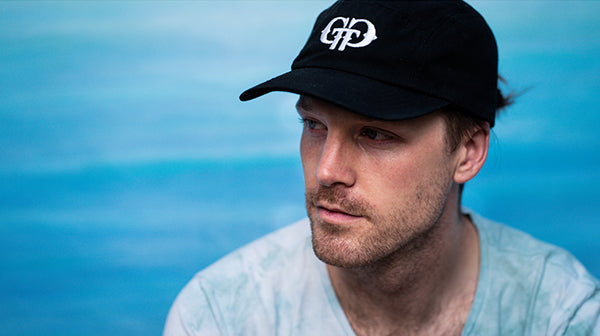
Artist Series 2024 | Danny Starr
Artist Danny Starr’s work ranges from pastoral landscapes soaked in sunlight to...
dragons, skulls, and portraits of people with melting faces that delve into the deep and murky waters of existentialism.

Artist Danny Starr in Brooklyn, N.Y.
At first glance, the breadth of his work seems incongruous, yet it makes sense when you consider that in every creative pursuit, one must master the fundamentals before bending the rules. His human figures—especially the hands, the hands!—are reminiscent of the great masters of realism he studied at the Angel Academy of Art in Florence, Italy, and the rest is, well, all Starr. His technique is what gives his imagination wings, and his passions—history, the human form, mythology, athletic pursuits, human nature—serve as the nest.
So, how did this cerebral artist tackle the challenge of designing topsheets for Wagner Custom? Starr, an avid snowboarder, focused not just on mountains, but on the feeling that being in the mountains brings. And the light—the light!—that comes with the storms that bring us so much joy.
“When we ski alone, there’s just you and the mountain and the elements,” Starr said. “I tried to capture that moment of sheer awareness of what’s all around you.”
We caught up with him recently from his home in Brooklyn, N.Y., to find out more about his art and what makes him tick. Here’s what he had to say.
Danny Starr's "Aurora"
Wagner: We hear you’re an avid snowboarder. Where did you grow up riding?
Starr: I grew up skiing mostly A-Basin [Colorado]. Keystone and Breck were always in the mix, but A-Basin taught me everything. I always love going back there. I remember when I was younger there would be seasons where they were open until July 4. That’s where I learned how to pond skim. I try to fly back to Colorado to get as much skiing in as I can.
Wagner: How did you get turned on to art?
Starr: I didn’t really recognize or accept the path until halfway through college. I’m a lefty, and I remember being able to draw as a 2- or 3-year-old. I could draw before I could talk, so drawing was my main form of communication growing up.
Danny Starr's "Evenfall"
Wagner: What made it click for you that you might want to pursue it as a career?
Starr: In college I studied graphic design but also got my history major in antiquity and renaissance. I got hooked on renaissance and baroque masters, like how does somebody make something like this. They were mysteries. I studied Da Vinci, Caravaggio, Rembrandt, and all these big names and attempted to find out how they did that. I became obsessed with painting at that point. I realized I had the hand, and now I had to go figure out how to turn this into a business.
Wagner: You are clearly a deep thinker. Where do your themes come from?
Starr: I became obsessed with the human figure and landscapes, but I’ve always wanted to take those talents and techniques and create stories or situations which can help potentially illuminate a viewer’s awareness.
Danny Starr's "Morning Glory"
Recently I’ve been painting my traditional way, and then finding ways to destroy it. I’m playing with his balance of order and chaos, form and destruction, and really trying to let the process of the act of painting create something accidental.
I get to honor and work on my technique and at the same time let go of the end product by purposely destroying it. I’m trying to find how the act of painting is a teacher, and it’s a metaphor for understanding a well-balanced life. I’m trying not to let the ego take over my technique. At the end of the day it’s the process that’s most important—that state of mind. A lot of the time all you see is the end product, and it’s nice to see the mess and steps along the way.

Danny Starr's "Olympus"
Wagner: That must be painful in a way.
Starr: It was at first. It’s getting a little better. Sometimes it’s like, ‘Ooo I like that part,’ and I’ll leave it alone. The ones that turn out best are the ones that are I think I’ve ruined. Then it dries, and I’m like, ‘This is really cool.’ It has that voice coming out of it.
Wagner: That’s a fascinating way to put it. That art has a voice.
Starr: It’s beautiful when it has something that radiates out of it.
Wagner: The thing that strikes me most about your topsheet art is the light. How do you do that?
Starr: It’s all about understanding your color law. I actually made these images up in my head. It’s understanding the values, keeping your lights in a group and darks in a group, and understanding atmosphere. The more saturated colors come closer to you, which helps you get the misty atmospheric contrast. And then there’ s a famous renaissance term called chiaroscuro, which is the technique of strong contrast to make light really pop.

Wagner: What impact do your surroundings have on your art?
Starr: Being around the city doesn’t inspire me to paint. For me personally, straight lines are a nightmare. I don’t like painting buildings. The galleries and other artists are the true inspiration for me out here. But Colorado is the best home. Luckily it’s not going anywhere.
For more about Danny Starr, check out his website or follow him on Instagram @dstarrart.
--
Article by Kimberly Beekman
Kimberly Beekman is the former editor-in-chief of the late, great Skiing Magazine (RIP), and a longtime editor of SKI Magazine before that. She currently uses the title of “freelancer” as a beard to ski powder all over the world. She lives in Steamboat, Colorado, with her wonderful daughter and terrible cat.













